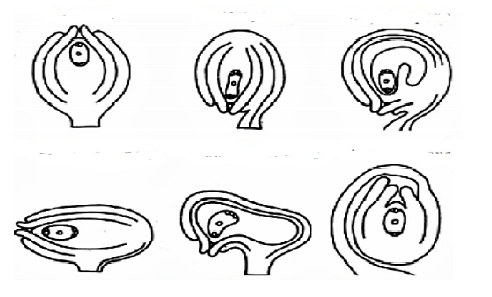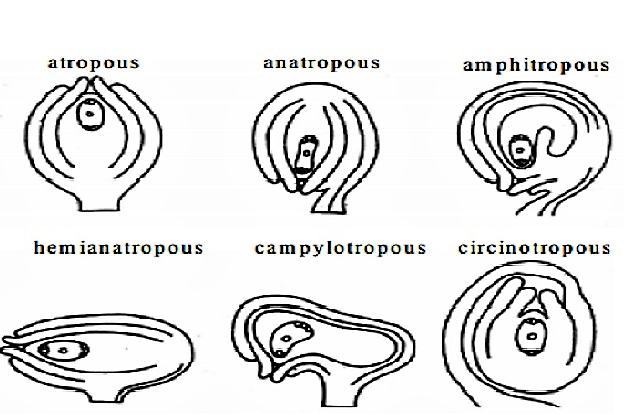
Given below are the different types of ovules. Identify A to F.

A. A-Circinotropous, B-Amphitropous, C-Campylotropous, D-Hemitropous, E-Anatropous, F-Orthotropous
B. A-Campylotropous, B-Anatropous, C-Hemitropous, D-Amphitropous, E-Circinotropous, F-Orthotropous
C. A-Orthotropous, B-Anatropous, C-Hemitropous, D-Campylotropous, E-Amphitropous, F-Circinotropous
D. A-Anatropous, B-Campylotropous, C-Hemitropous, D-Amphitropous, E-Circinotropous, F-Orthotropous

Answer
317.4k+ views
Hint: There are many things that go into fertilising a plant, but ovules may be the most important. Ovules are the female reproductive organs of flowering plants and are responsible for producing seeds. They contain everything that is needed to start a new plant - nutrients, water, and energy - which makes them an essential part of the agricultural process.
Step by step solution:
Orthotropous:
The micropyle, chalaza, and funicle are all in one straight line in an orthotropous ovule. For instance Polygonaceae, Piperaceae are ovules.
Anatropous: On bringing the micropyle and hilum very close together, the ovule's body is inverted wholly. This form of ovule is seen in 82% of angiosperm families. Plants are a gamopetalae subclass according to Bentham and Hooker classification.
Hemitropous ovule: When, the nucellus and integuments are at right angles to the funicle. Examples are the Ranunculaceae and Primulaceae families.
Campylotropous: When the ovule is crooked, the micropyle is aligned towards the chalaza. Chalaza is at right angles to the funicle. Members of the Cruciferae and Leguminosae families are two examples.
Amphitropous: The ovule curvature becomes more pronounced, and the embryo sac takes on a horseshoe form. Alismataceae and Butomaceae are two examples.
Circinotropous: Except for a small section at the end of the funicle, the funicle is extremely lengthy and forms a complete circle around the ovules.
Therefore, the correct arrangement from A to F is A-Orthotropous, B-Anatropous, C-Hemitropous, D-Campylotropous, E-Amphitropous, and F-Circinotropous

Fig: Different types of ovules.
Hence, the option C is correct
NOTE:
Angiosperms, or flowering plants, have their ovules covered. This stock, also known as the funicle or funiculus, joins the overview placenta to the placenta. The hilum is the place at which the funiculus attaches to the structure of the ovule.
Step by step solution:
Orthotropous:
The micropyle, chalaza, and funicle are all in one straight line in an orthotropous ovule. For instance Polygonaceae, Piperaceae are ovules.
Anatropous: On bringing the micropyle and hilum very close together, the ovule's body is inverted wholly. This form of ovule is seen in 82% of angiosperm families. Plants are a gamopetalae subclass according to Bentham and Hooker classification.
Hemitropous ovule: When, the nucellus and integuments are at right angles to the funicle. Examples are the Ranunculaceae and Primulaceae families.
Campylotropous: When the ovule is crooked, the micropyle is aligned towards the chalaza. Chalaza is at right angles to the funicle. Members of the Cruciferae and Leguminosae families are two examples.
Amphitropous: The ovule curvature becomes more pronounced, and the embryo sac takes on a horseshoe form. Alismataceae and Butomaceae are two examples.
Circinotropous: Except for a small section at the end of the funicle, the funicle is extremely lengthy and forms a complete circle around the ovules.
Therefore, the correct arrangement from A to F is A-Orthotropous, B-Anatropous, C-Hemitropous, D-Campylotropous, E-Amphitropous, and F-Circinotropous

Fig: Different types of ovules.
Hence, the option C is correct
NOTE:
Angiosperms, or flowering plants, have their ovules covered. This stock, also known as the funicle or funiculus, joins the overview placenta to the placenta. The hilum is the place at which the funiculus attaches to the structure of the ovule.
Recently Updated Pages
Capping is a process in which A adenylate is added class 12 biology NEET_UG

Explain in brief the separation and isolation of DNA class 12 biology NEET_UG

Number of testicular lobules in testes is A 250 B 500 class 12 biology NEET_UG

Why are manures considered better than fertilizers class 11 biology CBSE

Find the coordinates of the midpoint of the line segment class 11 maths CBSE

Distinguish between static friction limiting friction class 11 physics CBSE

Trending doubts
What is BLO What is the full form of BLO class 8 social science CBSE

What is meant by exothermic and endothermic reactions class 11 chemistry CBSE

Which places in India experience sunrise first and class 9 social science CBSE

What are the major means of transport Explain each class 12 social science CBSE

Which are the Top 10 Largest Countries of the World?

Fill the blanks with the suitable prepositions 1 The class 9 english CBSE




